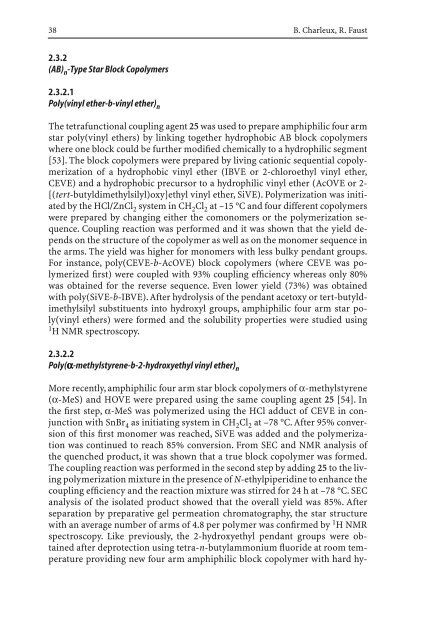142 Advances in Polymer Science Editorial Board: A. Abe. A.-C ...
142 Advances in Polymer Science Editorial Board: A. Abe. A.-C ...
142 Advances in Polymer Science Editorial Board: A. Abe. A.-C ...
Create successful ePaper yourself
Turn your PDF publications into a flip-book with our unique Google optimized e-Paper software.
38 B. Charleux, R. Faust<br />
2.3.2<br />
(AB) n -Type Star Block Copolymers<br />
2.3.2.1<br />
Poly(v<strong>in</strong>yl ether-b-v<strong>in</strong>yl ether) n<br />
The tetrafunctional coupl<strong>in</strong>g agent 25 was used to prepare amphiphilic four arm<br />
star poly(v<strong>in</strong>yl ethers) by l<strong>in</strong>k<strong>in</strong>g together hydrophobic AB block copolymers<br />
where one block could be further modified chemically to a hydrophilic segment<br />
[53]. The block copolymers were prepared by liv<strong>in</strong>g cationic sequential copolymerization<br />
of a hydrophobic v<strong>in</strong>yl ether (IBVE or 2-chloroethyl v<strong>in</strong>yl ether,<br />
CEVE) and a hydrophobic precursor to a hydrophilic v<strong>in</strong>yl ether (AcOVE or 2-<br />
[(tert-butyldimethylsilyl)oxy]ethyl v<strong>in</strong>yl ether, SiVE). <strong>Polymer</strong>ization was <strong>in</strong>itiated<br />
by the HCl/ZnCl 2 system <strong>in</strong> CH 2Cl 2 at –15 °C and four different copolymers<br />
were prepared by chang<strong>in</strong>g either the comonomers or the polymerization sequence.<br />
Coupl<strong>in</strong>g reaction was performed and it was shown that the yield depends<br />
on the structure of the copolymer as well as on the monomer sequence <strong>in</strong><br />
the arms. The yield was higher for monomers with less bulky pendant groups.<br />
For <strong>in</strong>stance, poly(CEVE-b-AcOVE) block copolymers (where CEVE was polymerized<br />
first) were coupled with 93% coupl<strong>in</strong>g efficiency whereas only 80%<br />
was obta<strong>in</strong>ed for the reverse sequence. Even lower yield (73%) was obta<strong>in</strong>ed<br />
with poly(SiVE-b-IBVE). After hydrolysis of the pendant acetoxy or tert-butyldimethylsilyl<br />
substituents <strong>in</strong>to hydroxyl groups, amphiphilic four arm star poly(v<strong>in</strong>yl<br />
ethers) were formed and the solubility properties were studied us<strong>in</strong>g<br />
1 H NMR spectroscopy.<br />
2.3.2.2<br />
Poly(a-methylstyrene-b-2-hydroxyethyl v<strong>in</strong>yl ether) n<br />
More recently, amphiphilic four arm star block copolymers of a-methylstyrene<br />
(a-MeS) and HOVE were prepared us<strong>in</strong>g the same coupl<strong>in</strong>g agent 25 [54]. In<br />
the first step, a-MeS was polymerized us<strong>in</strong>g the HCl adduct of CEVE <strong>in</strong> conjunction<br />
with SnBr 4 as <strong>in</strong>itiat<strong>in</strong>g system <strong>in</strong> CH 2 Cl 2 at –78 °C. After 95% conversion<br />
of this first monomer was reached, SiVE was added and the polymerization<br />
was cont<strong>in</strong>ued to reach 85% conversion. From SEC and NMR analysis of<br />
the quenched product, it was shown that a true block copolymer was formed.<br />
The coupl<strong>in</strong>g reaction was performed <strong>in</strong> the second step by add<strong>in</strong>g 25 to the liv<strong>in</strong>g<br />
polymerization mixture <strong>in</strong> the presence of N-ethylpiperid<strong>in</strong>e to enhance the<br />
coupl<strong>in</strong>g efficiency and the reaction mixture was stirred for 24 h at –78 °C. SEC<br />
analysis of the isolated product showed that the overall yield was 85%. After<br />
separation by preparative gel permeation chromatography, the star structure<br />
with an average number of arms of 4.8 per polymer was confirmed by 1 H NMR<br />
spectroscopy. Like previously, the 2-hydroxyethyl pendant groups were obta<strong>in</strong>ed<br />
after deprotection us<strong>in</strong>g tetra-n-butylammonium fluoride at room temperature<br />
provid<strong>in</strong>g new four arm amphiphilic block copolymer with hard hy-
















